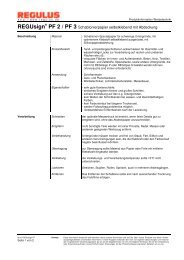STOCHASTIC HALFTONE SCREENING
STOCHASTIC HALFTONE SCREENING
STOCHASTIC HALFTONE SCREENING
You also want an ePaper? Increase the reach of your titles
YUMPU automatically turns print PDFs into web optimized ePapers that Google loves.
C G T T E C H N I C A L P U B L I C A T I O N S<br />
complex moiré problems as the halftone<br />
dot count got finer and finer. Hence, in an<br />
effort to minimize the mathematics of<br />
these complex halftone models, designers<br />
turned to the stochastic or FM dot as a<br />
possible way to minimize or eliminate the<br />
moiré common to imagesetter-based<br />
halftone generation. This came at a<br />
particularly good time as the cost of<br />
computing had dropped dramatically since<br />
the introduction of the first stochastic<br />
algorithms.<br />
In April 1993 both Agfa and Linotype-<br />
Hell announced the release of stochastic<br />
halftone screening for their imagesetters.<br />
There was a flurry of interest and attention<br />
centered on this early announcement.<br />
Unfortunately, implementation of the<br />
announced versions have some serious<br />
limitations that have not been totally<br />
overcome. Subsequent to the Agfa/<br />
Linotype-Hell announcement a number of<br />
other companies have released different<br />
models for different imagesetters. Scitex is<br />
among them, and Crosfield is about to<br />
release its version for their high-end<br />
scanners and imagesetters. Interest still<br />
remains high as more of the market finds<br />
out about the advantages of this type of<br />
halftone screening.<br />
Characteristics and comparisons<br />
Before we can begin to understand<br />
differences between conventional halftones<br />
and FM halftones, we need to clarify some<br />
terms. This can be very confusing. Conventional<br />
halftone screening works on the<br />
principle of ordered rows of dots, aligned<br />
to a grid of a specific ruling in lines per<br />
inch or lines per centimeter. This is called<br />
the halftone frequency. A traditional 150<br />
line halftone is a halftone with a frequency<br />
of 150 halftone dots per inch.<br />
This grid is usually aligned at some<br />
predetermined angle set, commonly 15°<br />
(105°), 45°, 75°, 90° (0°) for lithographic<br />
separations. The dot size varies with the<br />
tone value that is being reproduced. The<br />
halftone dot is generated from the center<br />
of the halftone cell out toward the edges<br />
and increases until 100% of the area is<br />
covered, representing solid coverage. The<br />
smallest addressable spot used to image the<br />
individual halftone cell is known as a pixel.<br />
The laser spot is the smallest size that<br />
the imaging laser can be focused to<br />
produce the pixels. The laser spot, also<br />
called dots per inch (dpi), can be considerably<br />
smaller than the pixel, depending on<br />
the frequency of the halftone. This is the<br />
case as the halftone dot becomes coarser.<br />
For very fine halftones (200 lines per inch<br />
and above), the pixel size approaches the<br />
laser spot size. Common laser spot sizes<br />
are 1200, 2400, 3600 dpi, and are typically<br />
20, 14, and 7 microns in size,<br />
respectively.<br />
The laser spot is the smallest area that<br />
the imaging laser can be focused to<br />
produce the pixels that make up the<br />
individual halftone. The laser spot is also<br />
measured in dots per inch (dpi), as in<br />
1270 dpi. The laser spot can be considerably<br />
smaller than the halftone pixel,<br />
depending on the frequency of the halftone.<br />
This is the case as the halftone dot<br />
becomes coarser. For very fine halftones<br />
(200 lines per inch and above,) the pixel<br />
size approaches the laser spot size. Common<br />
laser spot sizes are 1200, 2400, and<br />
3600 dpi, and are typically 20, 14, and 7<br />
microns in size, respectively.<br />
The FM dot is one uniform size. It<br />
works on the principle that the halftone<br />
cell is covered with many smaller pixels<br />
until the equivalent area is covered. The<br />
arrangement of these pixels varies randomly<br />
within each cell, with no two cells<br />
being identical. Because of this randomization,<br />
there is very little chance of developing<br />
a color to color moiré due to angular<br />
interference.<br />
TECH LIBRARY<br />
ONLINE<br />
TECHNICAL<br />
SUPPORT<br />
©1994 Coudray Graphic Technologies :: 805.541.1521 <strong>STOCHASTIC</strong> <strong>HALFTONE</strong> <strong>SCREENING</strong><br />
3
















